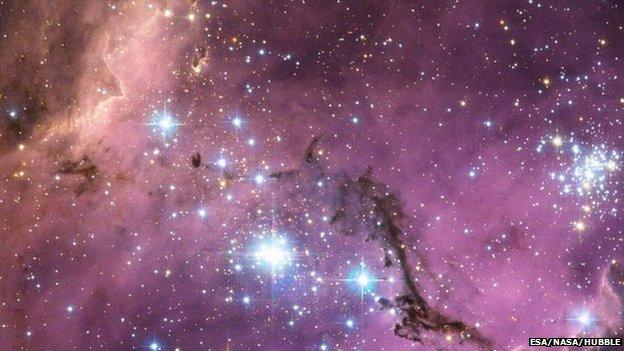Telescope's close-up of star nursery
- Published
ESO astronomer Dr Jeremy Walsh explains how the nebulae get their intense colour
The European Southern Observatory's (Eso) Very Large Telescope has seen a star-forming region in one of the Milky Way's satellite galaxies.
It has observed two distinctive clouds of gas which are about 160,000 light-years away.
The two nebulae - one red and one blue in colour - were both sculpted by powerful stellar winds from extremely hot newborn stars.
High-energy light from these new stars causes the clouds to glow brightly.
NHC 2014 has a red hue; neighbour NGC 2020 has a blue tint.
They are both in the Large Magellanic Cloud (LMC), the nearest dwarf galaxy to us, and are observable from the Southern Hemisphere.
The two nebulae are on the outskirts of the LMC and have very different, young brightly burning stars in them.
"They get their colours because they are lit up by stars... The photons from the star are received by the gas," explained Eso astronomer Jeremy Walsh.
"The energy of those photons goes into pumping the atoms into an excited state, and when they are like that they lose that energy mostly as radiation in the visible part of the spectrum."
The red nebula cloud is made up mostly of hydrogen gas. Its pink-tinge is due to the cluster of young hot stars illuminating it at about 25,000 degrees, added Dr Walsh.
The energetic radiation from these new stars strips electrons from the atoms within the surrounding hydrogen gas, ionising it and producing a characteristic red glow.
Massive young stars also produce powerful stellar winds that eventually cause the gas around them to disperse and stream away. This can be observed in the blue nebula where a very hot star appears inside a circular structure.
This nebula has a much hotter star in its centre than it red neighbour, likely to be up to 50,000 degrees.
"It ionises the gas, it kicks the electrons out the atoms and the atoms then radiate in spectral lines. That means this nebula is blue because it's emitting most of its radiation in a few lines," said Dr Walsh.
"You would need to go south of the equator to be able to see this nearby galaxy. It is about 160,000 light years away, which may sound like a lot but we have lots of galaxies which are much further away."
Viewing galaxies billions of light years away means you also see them much further back in time when they were just starting to assemble their stars. Telescopes like the VLT are doing this for galaxies that are 13 billion light years distant.
"There's a lot of star formation activity going on in this galaxy but it's a relatively small galaxy."

The Large Magellanic Cloud (LMC) is ablaze with star-forming regions
- Published8 March 2013
- Published18 February 2012
- Published8 March 2012
- Published12 October 2011